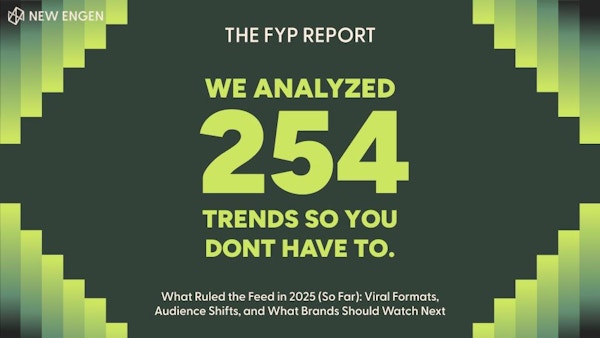How DTC Brands Will Reduce CAC in 2025—Without Spending Less
Why CAC Is the North Star Metric for DTC Growth in 2025
If 2021 was about scale at any cost, 2025 is about performance at the right cost. For digital-first brands, reducing customer acquisition cost (CAC) isn’t just a media challenge—it’s a full-system strategy issue. With investor expectations, rising platform costs, and shifting consumer behavior all putting pressure on margins, mastering CAC has become non-negotiable for Disruptor and DTC brands.
According to New Engen's 2025 Disruptor Growth Playbook, brands thriving in this environment are systemizing how they test, spend, and scale. CAC reduction is no longer a channel-level tactic—it's a cross-functional mission.
Understanding the True Scope of CAC
CAC isn’t just about media spend. It’s the sum total of your brand’s ability to convert interest into action—from ad creative and targeting to pricing strategy and site speed. Many brands misattribute high CAC to media performance alone, when in fact the issue may be messaging gaps, positioning misalignment, or poor funnel orchestration.
1. CAC Starts With Alignment Across the Funnel
Too often, CAC is viewed through a bottom-of-funnel lens. But Justin Hayashi, CEO at New Engen, explains that, "In this market, justifying your premium means proving performance at every touchpoint." In other words, the entire funnel matters—from the bottom to the top, each stage needs to pull its weight.
Many DTC brands under-invest in top-of-funnel awareness, then struggle to drive conversions because their performance efforts are targeting audiences who aren't yet familiar with their brand. At the same time, many struggle to measure middle-of-funnel signals—like engagement quality, landing page behavior, or brand lift indicators such as ad recall—because they lack the infrastructure to capture or act on those insights consistently.
For DTC teams focused on efficiency, full-funnel clarity isn’t a nice-to-have—it’s a must. The goal isn’t to spend less, it’s to spend smarter, with a system that ties every impression back to an intentional growth lever.
2. Use the Tools You Already Paid For
Measurement gaps are a quiet CAC killer. According to Kevin Goodwin, SVP of Strategy & Growth at New Engen, the issue isn’t usually a lack of tools—it’s that brands aren’t integrating them into decision-making in meaningful ways.
Before investing in anything new, audit your current stack. If you’re already using platforms like Northbeam or Triple Whale, the next step isn’t more data—it’s building a system to turn that data into action. Are you using those tools to guide creative testing? To inform your media roadmap? To iterate on audience strategy?
For many DTC teams, the measurement gap isn’t about access—it’s about adoption. Tools only work if they’re embedded in the way you experiment, evaluate, and evolve.
3. Positioning and Pricing as CAC Levers
Many DTC brands price for premium but market like they’re selling a deal, but this mismatch can inflate CAC. More often than not, brands wind up paying more to convince skeptical customers rather than leading with clarity. When price-to-value alignment is clear from the very first touchpoint, brands earn trust faster and convert more efficiently.
If your CAC is climbing, revisit your messaging. Are your prices transparent and easily justified? Today’s top-performing brands are clear on their products’ cost and why, both in principle and in practice—with landing pages and creative that justify pricing at every stage of the funnel.
4. Build Always-On Testing Infrastructure
Too many campaigns are still run without the proper testing infrastructure in place to guide decisions and reduce inefficiencies. And it’s not just early-stage brands or young companies—even sophisticated brands are guilty of dropping the ball on formalized creative testing.
One-off campaign testing isn't enough. Brands need testing infrastructure that functions year-round, with frameworks tied to funnel stages, audience segments, and hypotheses. Structured testing plans, modular asset systems, and clear feedback loops transform creative into a performance driver—not a guessing game.
5. Diversify Your Channel Mix With Purpose
The media landscape is crowded, expensive, and increasingly fragmented. DTC brands still leaning too heavily on Meta are vulnerable to platform volatility and rising CPAs. Diversifying your channel mix isn’t just a hedge—it’s a growth strategy.
From TikTok and Pinterest to Reddit and affiliate, forward-thinking brands are experimenting across channels with distinct, creative-native approaches. What matters is not being everywhere—it’s being intentional about where you show up and how.
6. Make Attribution a Team Sport
Murky attribution often masks inefficiencies—and can stall growth. Relying solely on last-click or in-platform metrics keeps teams guessing about what’s really driving performance.
To get smarter about spend, brands are layering in incrementality testing (like geo-holdouts), integrating signal-based metrics like brand lift and search interest, and using multi-touch models to evaluate impact across the funnel.
7. Activate First-Party Data With Intention
With third-party data disappearing, brands must get smarter with what they own. Efficient CAC in 2025 relies on clean, actionable first-party and zero-party data strategies. That means stronger segmentation, more intentional flows, and frictionless journeys that extend LTV.
8. Build Infrastructure for Repeatable Growth
Reducing CAC at scale takes more than good instincts—it takes systems. That means aligning your creative process, media planning, data interpretation, and team operations around a shared growth engine.
Brands that win in 2025 are operationalizing learnings, not just reacting to outcomes. They're documenting what works, templatizing test designs, and ensuring insights are distributed across creative, media, and product teams.
From Channel Tactics to Growth Systems: Rethinking CAC in 2025
For DTC brands, reducing CAC in 2025 isn’t about spending less—it’s about spending smarter. By aligning every part of the growth engine—from creative to channel strategy to measurement—brands can lower acquisition costs while scaling impact.
Want to go deeper? Download the 2025 Disruptor Growth Playbook to access proprietary benchmarks, creative systems, and strategic models that help DTC brands grow efficiently in today’s market.
Frequently Asked Questions (FAQs)
What’s the biggest driver of high CAC for DTC brands in 2025?
Many DTC brands still over-index on bottom-of-funnel tactics while under-investing in awareness and consideration. Without full-funnel alignment, lower-funnel performance suffers—and CAC rises as a result.
How are DTC teams making better use of their measurement tools?
The issue isn’t access to tools like Northbeam or Triple Whale—it’s adoption. The most effective teams are embedding data into creative testing, audience targeting, and media planning workflows.
What role does positioning play in reducing CAC?
When there's misalignment between premium pricing and performance-driven messaging, brands end up spending more to justify value. Positioning and pricing clarity—reinforced throughout the funnel—leads to faster trust and more efficient conversion.
How are top DTC brands building test-and-learn infrastructure?
Rather than treating testing as a one-off tactic, leading brands are creating always-on systems. These include modular creative frameworks, structured test plans, and cross-functional feedback loops to scale what works and reduce wasted spend.
Why is channel diversification critical to CAC efficiency in 2025?
Relying solely on Meta leaves brands exposed to volatility and rising CPAs. Disruptors are testing into channels like Reddit, CTV, and affiliate with creative-native strategies—allowing for broader reach and stronger signal resilience.



